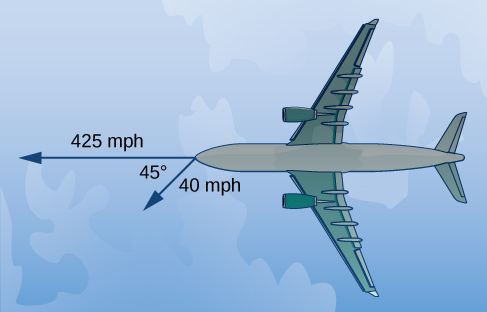| << Chapter < Page | Chapter >> Page > |
Let and let be a unit vector that forms an angle of with the positive x -axis. Express and in terms of the standard unit vectors.
Because vectors have both direction and magnitude, they are valuable tools for solving problems involving such applications as motion and force . Recall the boat example and the quarterback example we described earlier. Here we look at two other examples in detail.
Jane’s car is stuck in the mud. Lisa and Jed come along in a truck to help pull her out. They attach one end of a tow strap to the front of the car and the other end to the truck’s trailer hitch, and the truck starts to pull. Meanwhile, Jane and Jed get behind the car and push. The truck generates a horizontal force of lb on the car. Jane and Jed are pushing at a slight upward angle and generate a force of lb on the car. These forces can be represented by vectors, as shown in [link] . The angle between these vectors is Find the resultant force (the vector sum) and give its magnitude to the nearest tenth of a pound and its direction angle from the positive x -axis.

To find the effect of combining the two forces, add their representative vectors. First, express each vector in component form or in terms of the standard unit vectors. For this purpose, it is easiest if we align one of the vectors with the positive x -axis. The horizontal vector, then, has initial point and terminal point It can be expressed as or
The second vector has magnitude and makes an angle of with the first, so we can express it as or Then, the sum of the vectors, or resultant vector, is and we have
The angle made by and the positive x -axis has so which means the resultant force has an angle of above the horizontal axis.
An airplane flies due west at an airspeed of mph. The wind is blowing from the northeast at mph. What is the ground speed of the airplane? What is the bearing of the airplane?
Let’s start by sketching the situation described ( [link] ).

Set up a sketch so that the initial points of the vectors lie at the origin. Then, the plane’s velocity vector is The vector describing the wind makes an angle of with the positive x -axis:
When the airspeed and the wind act together on the plane, we can add their vectors to find the resultant force:
The magnitude of the resultant vector shows the effect of the wind on the ground speed of the airplane:
As a result of the wind, the plane is traveling at approximately mph relative to the ground.
To determine the bearing of the airplane, we want to find the direction of the vector
The overall direction of the plane is south of west.

Notification Switch
Would you like to follow the 'Calculus volume 3' conversation and receive update notifications?